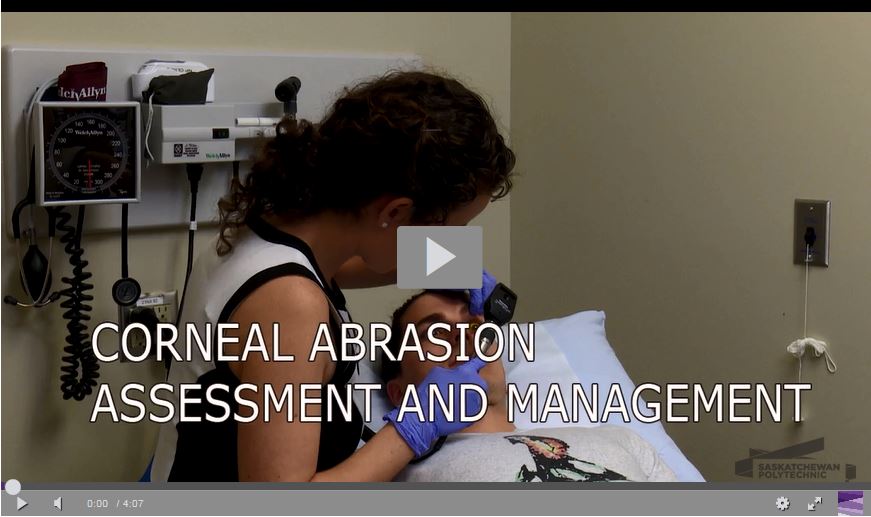Corneal Abrasion Assessment and Management
Step 1: Health history and physical assessment
Assess timing of the complaint, mechanism of injury, eye surgeries, prescription drop use, corrective glasses/contact lens use. Anesthetize as needed to facilitate a thorough eye examination.
Physical assessment:
- Visual acuity (Snellen eye chart, near vision)
- Visual fields (confrontation test)
- Extraocular muscle function (corneal light reflex, cover test, cardinal positions of gaze)
- External eye structures
- Anterior eyeball structures (cornea and lens, iris and pupil)
- Ocular fundus (elicit red light reflex at minimum)
Step 2: Instill ophthalmic anesthetic drops
Pull down on the lower eye lid to create a well. Tilt the client’s head back and instill 1-2 drops. Have the patient blink to distribute the drops. Instill just prior to evaluation.Tetracaine: onset of action 30 seconds; duration of action 10-20 minutes.
Step 3: Instill fluorescein stain
Pull down the lower lid and allow a drop of the fluorescein stain to run off into the eye. Have the patient blink to distribute the stain over the ocular surface.
Note: The fluorescein stain examination should only be completed after the assessment of visual acuity, penlight examination of the pupils, and the fundus. Instillation prior may interfere with visual acuity measurement and visualization of the pupils and fundus.
Step 4: Inspect the cornea
Step 5: Assess for retained foreign body under the upper lid
- Ask patient to keep both eyes open and look down to keep the eyelid relaxed
- Slide upper lid along bony orbit to life up the eyelashes
- Grasp the eyelashes between your thumb and forefinger and pull down and outward
- Use the other hand to place the cotton-tipped applicator on the upper eye lid
- Push down with the stick as the lashes are lifted up to flip the upper eyelid inside out. Do not push on the eyeball with the stick
- Maintain the everted position by holding the lashes against the bony orbit rim
- Inspect for foreign bodies, color changes, swelling, or lesions
See chapter titled “Removal of Foreign Body (Eye)” if present.
Step 6: Prescribe topical antibiotic therapy if corneal abrasion present
Non contact lens wearers:
• Erythromycin ointment QID x 3-5 days
Contact lens wearers:
• Choose antibiotic with pseudomonas coverage such as a fluoroquinolone

